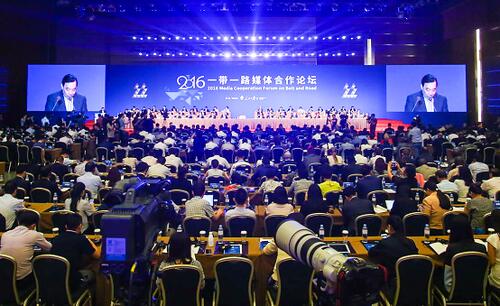


The 2017 Media Cooperation Forum on Belt and Road kicked off on Sept. 19 in Dunhuang, northwestern China’s Gansu province.
Dunhuang, which means tremendous prosperity in Chinese, is an important city along the Belt and Road. At the forum, where media collided with culture, the representatives witnessed the trend of development in the ancient city started by the ancient Silk Road.
Since 2014, the Media Cooperation Forum on Belt and Road has attracted worldwide attention for four consecutive years. Just like what People’s Daily President Yang Zhenwu said, the forum has formed a strong magnetic effect.
As a matter of fact, the 300 Chinese and foreign media outlets are not the only attraction at the forum. Pavel Negoitsa, director of Russian newspaper Rossiyskaya Gazeta, said people are fed up with fear, anxiety, wars, and terrorist attacks, and are in need of hope.
The Belt and Road Initiative has been actively supported and participated in by more than 100 countries and international organizations during the four years since it was proposed, and key solutions of the United Nations have also been incorporated into the scope of the initiative. This has created hope for people.
Large petroleum drills have been sent to Turkmenistan by international freight trains; Mombasa–Nairobi Standard Gauge Railway has halved the commute time between the two cities; and university students from Uzbekistan came to Shenzhen to study 4G base stations. The Belt and Road Initiative is a carrier of dreams and a torch of hope.
From ideas to actions and from visions to reality, the initiative has created $1.1 billion in tax revenue and more than 180,000 jobs for participating countries.
The Belt and Road Initiative came at the right moment, when economic globalization needed a guiding hand. “Economic globalization reaches from sea to land,” said Zheng Bijian, chairman of China Institute for Innovation and Development Strategy, adding that we are in an unprecedented phase of globalization in human history.

(File Photo)
Numerous people have started their journey along the Belt and Road, which is a path of hope.
Gansu province used to be an important passage on the ancient Silk Road. From the dazzling exhibits at the Silk Road (Dunhuang) International Cultural Expo, to the vegetables and fruits shipped to overseas destinations aboard China-Europe freight trains, this province in western China is striding toward the international arena.
Hainan, a province located on the maritime Silk Road, has opened 52 lanes to foreign destinations and signed more than 60 agreements with countries and regions along the Belt and Road, replaying the prosperity of the flourishing seaway.
Zheng noted that both maritime and inland economies will promote the overall development of China from east to west when explaining why the initiative has been welcomed by both coastal and inland regions. It is a new round of interactive development, he added.
The Belt and Road is not only about economy, it is also about culture. Dunhuang has always been a connecting point, serving as a link between the four major cultural systems in China, India, Greece, and the Islamic world. Different cultures collided and communicated with each other here for thousands of years, enriching the history of human civilization.
A scholar once proved that tiger hat, a traditional child wear in Chinese culture, indeed originated from the hat worn by the divine hero Heracles in Greek mythology.
José Vera, president of Spanish news agency Agencia EFE, said that Dunhuang served as a resting point for ancient caravans before they entered the desert, a place where eastern and western intelligences gathered. The media cooperation forum, with a vision on cultural communication based on the framework of the Belt and Road, aims to achieve more possibilities of human civilization through the collision of ideas between east and west, ancient and modern times.
Nowadays, people don’t have to cross thousands of miles to communicate with different cultures. All they need to do is to click their mouse. However, cultural communication is not as smooth as what people imagine.
Robin Li, the CEO of Chinese technology giant Baidu, shared his experience at the forum. When travelling along the Belt and Road, he has to bring socket converters, because of the different plug types and voltages in different countries. This seemingly minor technical matter is indeed a reflection of different histories and national conditions.
Compared with ancient cultural communication, modern cultural exchanges are much faster. In the age of information and globalization, civilization dialogues are the essence to bring closer the people with different cultural backgrounds.
Chinese President Xi Jinping summarized the Silk Road spirit as “peace and cooperation, openness and inclusiveness, mutual learning and mutual benefit,” in a bid to inherit the valuable legacy and pursue more achievements.
U Win Tin, a famous journalist in Myanmar, noted at the forum that the Belt and Road is both help and hope.
Our forefathers established friendships across continents and oceans, including Chinese imperial envoy Zhang Qian and Chinese diplomat Zheng He, who commanded expeditionary voyages around the world in Ming Dynasty, and Venetian merchant traveler Marco Polo. Nowadays, by promoting the construction of the Belt and Road, the world will definitely embrace new hopes and possibilities.
 Fire brigade in Shanghai holds group wedding
Fire brigade in Shanghai holds group wedding Tourists enjoy ice sculptures in Datan Town, north China
Tourists enjoy ice sculptures in Datan Town, north China Sunset scenery of Dayan Pagoda in Xi'an
Sunset scenery of Dayan Pagoda in Xi'an Tourists have fun at scenic spot in Nanlong Town, NW China
Tourists have fun at scenic spot in Nanlong Town, NW China Harbin attracts tourists by making best use of ice in winter
Harbin attracts tourists by making best use of ice in winter In pics: FIS Alpine Ski Women's World Cup Slalom
In pics: FIS Alpine Ski Women's World Cup Slalom Black-necked cranes rest at reservoir in Lhunzhub County, Lhasa
Black-necked cranes rest at reservoir in Lhunzhub County, Lhasa China's FAST telescope will be available to foreign scientists in April
China's FAST telescope will be available to foreign scientists in April "She power" plays indispensable role in poverty alleviation
"She power" plays indispensable role in poverty alleviation Top 10 world news events of People's Daily in 2020
Top 10 world news events of People's Daily in 2020 Top 10 China news events of People's Daily in 2020
Top 10 China news events of People's Daily in 2020 Top 10 media buzzwords of 2020
Top 10 media buzzwords of 2020 Year-ender:10 major tourism stories of 2020
Year-ender:10 major tourism stories of 2020 No interference in Venezuelan issues
No interference in Venezuelan issues
 Biz prepares for trade spat
Biz prepares for trade spat
 Broadcasting Continent
Broadcasting Continent Australia wins Chinese CEOs as US loses
Australia wins Chinese CEOs as US loses